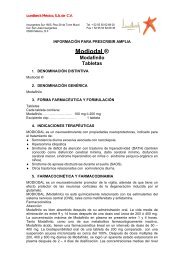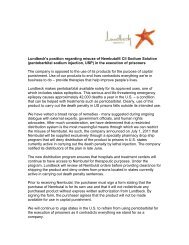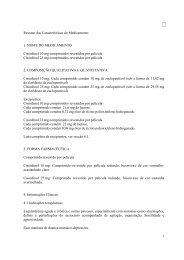Download - Lundbeck
Download - Lundbeck
Download - Lundbeck
Create successful ePaper yourself
Turn your PDF publications into a flip-book with our unique Google optimized e-Paper software.
24 <strong>Lundbeck</strong> Magazine 2009<br />
"Unfortunately, there are<br />
still major differences in the<br />
treatment on offer to patients in<br />
different countries in Europe"<br />
Everyone agrees that patients with a<br />
myocardial infarct should be treated by<br />
cardiologists, but the attitude was that anyone<br />
could treat stroke patients,” Markku Kaste says.<br />
When he was able to document on the basis<br />
of a study that stroke patients who had been<br />
treated by neurologists were able to leave<br />
hospital 16 days earlier than those treated in<br />
other wards, and that more were discharged to<br />
their own homes and were also better able to<br />
care for themselves without help, the Helsinki<br />
City Council saw the light. That happened in<br />
1995. The stroke unit at HUCH Meilahti<br />
hospital has since treated all acute stroke<br />
patients in Helsinki. The experience gained in<br />
acute care of stroke has been formulated as<br />
European guidelines. The recommendations,<br />
previously written by a task force of the<br />
European Stroke Initiative (EUSI) and later on<br />
by the European Stroke Organisation (ESO),<br />
both of which Markku Kaste helped found, are<br />
available in multiple languages.<br />
Four out of ten neglected<br />
“Unfortunately, there are still major differences<br />
in the treatment on offer to patients in<br />
different countries in Europe. Recently we<br />
asked 4261 randomly selected hospitals<br />
throughout the EU about their treatment of<br />
stroke, and the results were shocking. Only one<br />
out of seven patients – between 13 and 14 per<br />
cent – were treated as recommended by WHO<br />
i.e. in a stroke unit at a university hospital or<br />
other well equipped hospital, which has<br />
neurologists, cardiologists, neurosurgeons,<br />
vascular surgeons, and a CT scanner that is<br />
manned 24 hours a day. Forty-four per cent<br />
receive acceptable treatment, generally at<br />
large hospital centres. But the remaining 42<br />
per cent are treated in hospitals that lack both<br />
equipment and experience. And this happens<br />
in rich countries as well as in poor. This is not<br />
only appalling for patients, it is also costly for<br />
society,” Markku Kaste says.<br />
Too weak to bang on the table<br />
Stroke is an illness which costs society a lot<br />
of money. “In Finland, caring for a patient in<br />
a nursing home costs EUR 50,000 per year.<br />
As strokes generally occur in persons between<br />
the ages of 60 and 70, their life expectancy is<br />
higher than, for example, persons with<br />
dementia, who are usually older when they<br />
enter a nursing home. Stroke is exceedingly<br />
expensive for society, but those who have<br />
suffered a stroke are too weak to bang on<br />
the table and demand better treatment. This<br />
makes it important to prevent the illness –<br />
also from an economic point of view,”<br />
Professor Kaste continues.<br />
The factors that can cause stroke are the same<br />
as those that can cause cardiovascular<br />
diseases: high blood pressure, high cholesterol,<br />
obesity, smoking, high alcohol consumption<br />
and lack of physical exercise.<br />
Quick treatment makes the difference<br />
“It is therefore possible to do something<br />
oneself, and prevention is of course the best<br />
mode of action. But for those who suffer a<br />
stroke anyway, it is important for society to<br />
invest in stroke units where it is possible to<br />
obtain the best possible treatment, which<br />
increases the likelihood of good recovery. With<br />
the present drugs for dissolving blood clots, we<br />
consider it possible to save many patients up<br />
until four and a half hours of the time of the<br />
symptom onset and in some patients even<br />
after longer time before irreversible damage<br />
occurs. We are currently investigating a new<br />
drug which may give us as much as nine hours,<br />
and thus more time to get patients to<br />
hospitals that can provide the right treatment.<br />
Some patients cannot tolerate drugs that solve<br />
the blood clot, which occludes the brain artery,<br />
for example if they have very high blood<br />
pressure or internal bleeding. But quick arrival<br />
at the hospital and appropriate treatment<br />
benefit all patients. Competent intervention by<br />
a wide spectrum of specialists reduces the risk<br />
of the patient dying or becoming helpless and<br />
requiring care. Quick and correct treatment is<br />
good for the individual patient, and a major<br />
economic benefit for society,” says Professor<br />
Markku Kaste.<br />
PHOTO: Joachim ladefoged










![[Product Monograph Template - Standard] - Lundbeck](https://img.yumpu.com/49015733/1/190x245/product-monograph-template-standard-lundbeck.jpg?quality=85)






